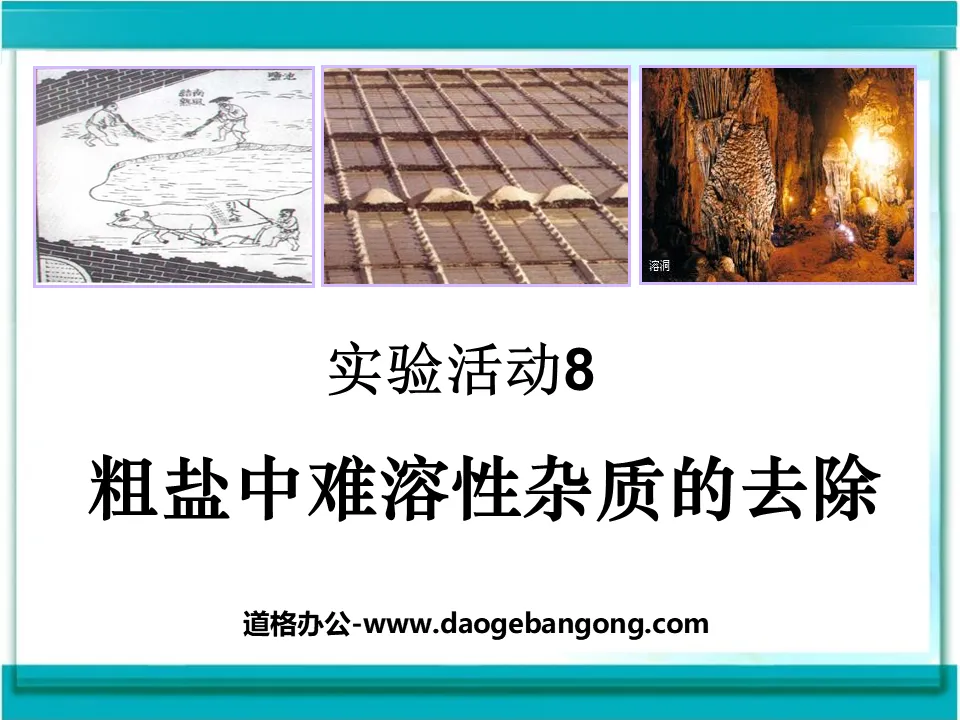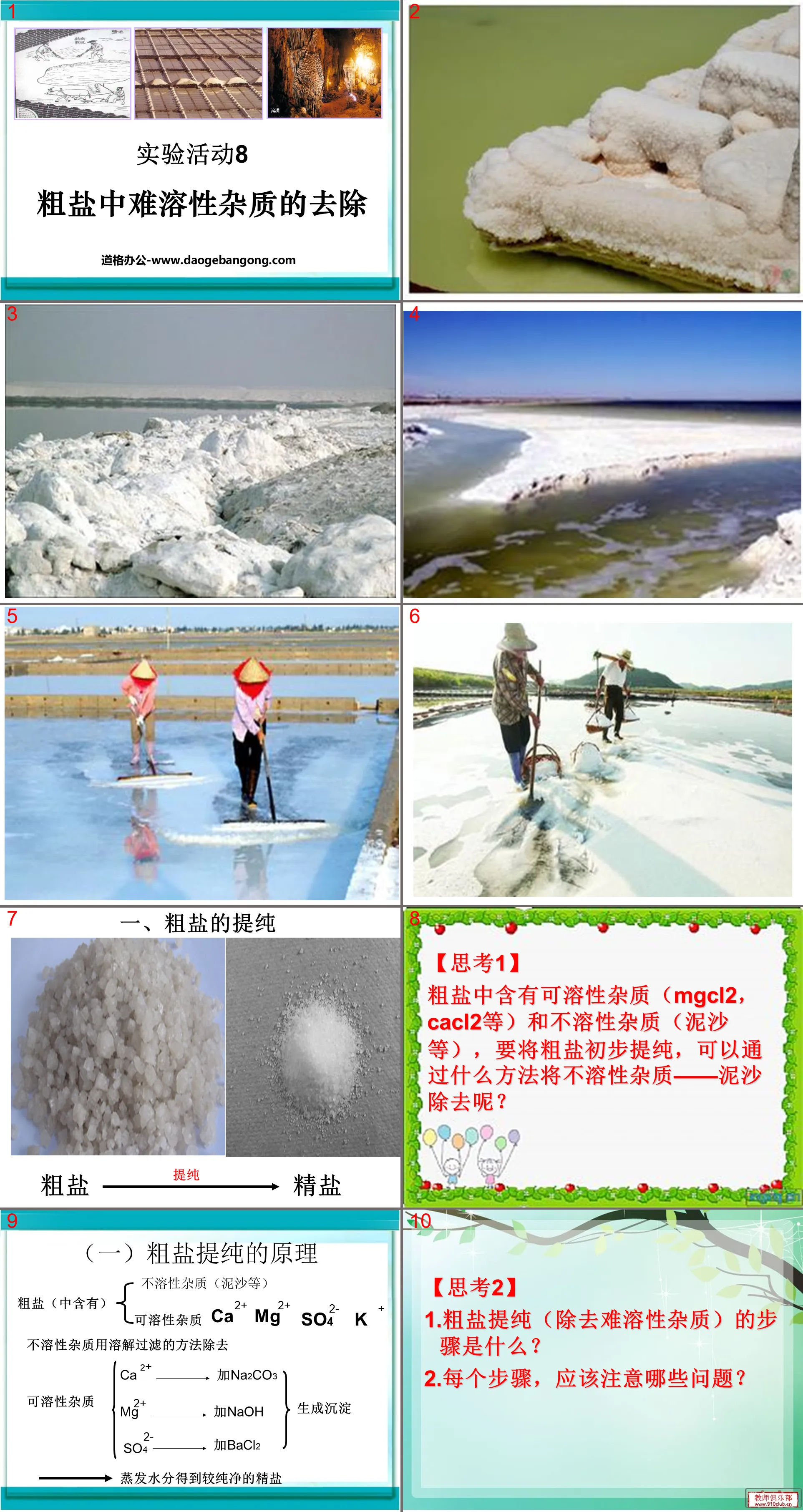People's Education Press High School Chemistry Compulsory Course I
Cantonese Education Edition Ninth Grade Chemistry Volume 1
Beijing Curriculum Reform Edition Ninth Grade Chemistry Volume 2
People's Education Press Ninth Grade Chemistry Volume 1
Beijing Curriculum Reform Edition Ninth Grade Chemistry Volume 1
Lu Ke Edition High School Chemistry Compulsory Course 1
Lu Jiao Edition Ninth Grade Chemistry Volume 1
People's Education Press Ninth Grade Chemistry Volume 2
Cantonese Education Edition Ninth Grade Chemistry Volume 2
Hunan Education Edition Ninth Grade Chemistry Volume 1
Lu Ke Edition High School Chemistry Compulsory Course 2
People's Education Press High School Chemistry Compulsory Course 2
Hunan Education Edition Ninth Grade Chemistry Volume 2
Lu Jiao Edition Ninth Grade Chemistry Volume 2

| Category | Format | Size |
|---|---|---|
| People's Education Press Ninth Grade Chemistry Volume 2 | pptx | 6 MB |
Description
"Removal of Insoluble Impurities in Coarse Salt" Salt Fertilizer PPT Courseware 3
【Thinking 1】
Coarse salt contains soluble impurities (MgCl2, CaCl2, etc.) and insoluble impurities (sediment, etc.). To initially purify coarse salt, what method can be used to remove the insoluble impurities - sediment?
【Thinking 2】
1. What are the steps for purifying crude salt (removing insoluble impurities)?
2. What issues should be paid attention to in each step?
1. Dissolve
Recall the use of scales:
(1) Place it on a horizontal table
(2) Adjust the left balance nut
(3) Weighing objects on the left and weight on the right
(4) Reading m object = m weight + m travel code reading
[Thinking 3] What should we pay attention to during dissolution operation?
1. It is not advisable to add too much coarse salt at one time to avoid adding too much salt and not being able to dissolve it.
2. When dissolving and stirring, the glass rod should be controlled and try not to touch the wall of the beaker.
2. Filter
One sticker: The filter paper sticks to the inner wall of the funnel
Second low
①The edge of the filter paper should be lower than the edge of the funnel;
②The liquid level in the funnel should be lower than the edge of the filter paper.
Three things to rely on:
① When filtering, the glass rod should be placed against the side with three layers of filter paper.
②The mouth of the beaker should be close to the glass rod;
③The lower end of the funnel should be close to the inner wall of the beaker to prevent droplets from splashing.
Want to discuss
After filtering the crude salt solution, if the filtrate is still turbid, what might be the reason?
1. The filter paper is damaged.
2. The filtrate is higher than the edge of the filter paper.
3. The beaker that receives the filtrate is not clean (contains impurities).
[Thinking 4] What should we pay attention to during evaporation operation?
1. The evaporating dish should be placed on the iron ring and heated with an alcohol lamp. When heating is stopped, do not place the evaporating dish directly on the experimental table immediately to avoid scalding the experimental table.
2. During the heating process, use a glass rod to stir continuously to prevent droplets from splashing due to excessive local temperature.
3. When more solids (crystals) appear in the evaporating dish, stop heating and use the residual heat to evaporate the filtrate to dryness.
Summary: Steps for purifying coarse salt:
Dissolve:
Filtering: Key points of filtering (one post, two low and three depend)
Evaporation: (Do I need to evaporate all the water before extinguishing the alcohol lamp?)
Recovery and calculation of yield: mass of purified refined salt/mass of coarse salt x 100%
The glass rod is used 4 times in the operation. What are its functions?
Dissolution: Stirring to speed up the dissolution of salt Filtration: Drainage to prevent liquid from splashing out
Evaporation: Stir to prevent droplets from splashing Calculate yield: Transfer solids
2. Removal of impurities from substances
1. The removal of impurities from substances is also called the purification of substances. Its purpose is to remove a small amount of ___________ from the mixture to obtain a purer substance.
2. Material removal follows three principles:
①No new ___________ can be added during the purification process;
②Do not reduce the purified substances, that is, the added reagents only react with ___________ and not with ___________;
③Easy to separate.
3. A certain salt sample contains a small amount of sand, calcium chloride and magnesium chloride. The following is a flow chart designed by a classmate to extract sodium chloride with coarse salt.
(1) Ask students to discuss their design intentions and fill in the blanks.
(2) Discuss and summarize the principles and basic methods of material impurity removal.
Answer according to the flow chart:
(1) The name of operation I is ___________, the reagent A added is ___________, and the precipitation is ___________;
(2) Write the chemical equation___________ for the reaction between NaOH and impurities;
(3) The reagent B added is ___________, and the purpose is ___________;
(4) The function of the glass rod used in evaporation and crystallization is ___________.
Class exercises
The steps for purifying coarse salt are: , , .
In the experiment of purifying coarse salt, glass rods are used in all three steps. Their functions are (fill in the serial number):
(1) The function of dissolving is ( )
(2) The function of filtering is ( )
(3) The function of evaporation is ( )
A. Stir to accelerate solid dissolution
B. Stir to prevent droplets from splashing
C. Drainage and prevent liquid from splashing out
In the experiment of purifying coarse salt, which of the following operations is wrong ( )
A. After filtering the crude salt solution, if the filtrate is still turbid, it should be filtered again
B. Place the evaporating dish on the iron ring and heat it directly with an alcohol lamp
C. During the heating process, use a glass rod to continuously stir the liquid
D. When all the water in the evaporating dish is evaporated, stop heating.
Keywords: Salt fertilizer teaching courseware, Removal of poorly soluble impurities in coarse salt teaching courseware, New People's Education Press ninth grade chemistry PPT courseware for the second volume, Ninth grade chemistry slide courseware download, Salt fertilizer PPT courseware download, Slowly soluble impurities in coarse salt Impurity removal PPT courseware download, .ppt format
For more information about the PPT courseware "Removal of Insoluble Impurities in Coarse Salt of Salt Chemical Fertilizer", please click on the Removal of Insoluble Impurities in Coarse Salt of Salt Chemical Fertilizer ppt ppt tag.
"Removal of Insoluble Impurities in Coarse Salt" Salt Fertilizer PPT Courseware 4:
"Removal of Insoluble Impurities in Coarse Salt" Salt Fertilizer PPT Courseware 4 Steps for the removal of insoluble impurities in coarse salt: ① Dissolve, ② Filtration, ③ Evaporation ④ Calculate yield 1., Dissolve [ Weigh (left matter Right code)] Instruments: tray balance, medicine spoon, beaker, glass rod, measuring cylinder..
"Removal of Insoluble Impurities in Coarse Salt" Salt Fertilizer PPT Courseware 2:
"Removal of Insoluble Impurities in Coarse Salt" Salt Fertilizer PPT Courseware 2 Removal of Insoluble Impurities in Coarse Salt 1. Dissolution 2. Filtration 3. Evaporation to remove insoluble impurities in coarse salt. During filtration, attention should be paid to: one post, two low, three high 4. Yield: refined salt/coarse salt 100% ... ... ...
"Removal of Insoluble Impurities in Coarse Salt" Salt Fertilizer PPT Courseware:
"Removal of Insoluble Impurities in Coarse Salt" Salt Fertilizer PPT Courseware By drying seawater or boiling salt well water, salt lake water, etc., the water can be evaporated to remove sodium chloride crystal coarse salt containing more impurities. Note: 1. Pure table salt does not deliquesce in the air. 2. Coarse salt...
File Info
Update Time: 2024-11-17
This template belongs to Chemistry courseware People's Education Press Ninth Grade Chemistry Volume 2 industry PPT template
"Removal of Insoluble Impurities in Coarse Salt" Salt Fertilizer PPT Courseware 3 Simple campus recruitment activity planning plan summary enterprise and institution recruitment publicity lecture PPT template is a general PPT template for business post competition provided by the manuscript PPT, simple campus recruitment activity planning plan summary enterprise and institution recruitment promotion Lecture PPT template, you can edit and modify the text and pictures in the source file by downloading the source file. If you want more exquisite business PPT templates, you can come to grid resource. Doug resource PPT, massive PPT template slide material download, we only make high-quality PPT templates!
Tips: If you open the template and feel that it is not suitable for all your needs, you can search for related content "Removal of Insoluble Impurities in Coarse Salt" Salt Fertilizer PPT Courseware 3 is enough.
How to use the Windows system template
Directly decompress the file and use it with office or wps
How to use the Mac system template
Directly decompress the file and use it Office or wps can be used
Related reading
For more detailed PPT-related tutorials and font tutorials, you can view: Click to see
How to create a high-quality technological sense PPT? 4 ways to share the bottom of the box
Notice
Do not download in WeChat, Zhihu, QQ, built-in browsers, please use mobile browsers to download! If you are a mobile phone user, please download it on your computer!
1. The manuscript PPT is only for study and reference, please delete it 24 hours after downloading.
2. If the resource involves your legitimate rights and interests, delete it immediately.
3. Contact information: service@daogebangong.com
"Removal of Insoluble Impurities in Coarse Salt" Salt Fertilizer PPT Courseware 3, due to usage restrictions, it is only for personal study and reference use. For commercial use, please go to the relevant official website for authorization.
(Personal non-commercial use refers to the use of this font to complete the display of personal works, including but not limited to the design of personal papers, resumes, etc.)
Preview










